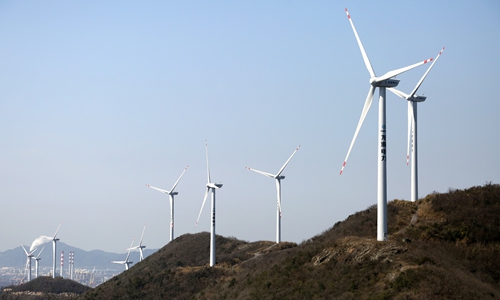China’s carbon neutrality goal to advance global schedule by 5-10 years
By Shan Jie Source: Global Times Published: 2020/9/27 22:03:40

Photo: cnsphoto
China has vowed to achieve carbon neutrality before 2060, a huge challenge and responsibility for the world's largest developing country to commit to as part of global society to lead green development, and the bold target may advance the schedule for global carbon neutrality by 5-10 years, environmental experts said.
During the economic and energy transitions, China can take advantage of the opportunities to create more high-quality jobs and improve livelihood, experts noted.
China aims to peak CO2 emissions before 2030 and achieve carbon neutrality before 2060, Chinese President Xi Jinping announced Tuesday at the general debate of the 75th session of the United Nations General Assembly via video link. "China will scale up its Intended Nationally Determined Contributions by adopting more vigorous policies and measures," he said, according to the Xinhua News Agency.
Chinese experts and senior officials believe that the goal, as a guide to green development, will "force" China to transition its economic development and promote high-quality development, bringing benefits to environment and people.
"The new-energy industry, such as wind power and solar energy, can provide 1.5 to 3 times the jobs of the traditional energy sector," He Jiankun, Deputy Director of the National Committee of Experts on Climate Change and former president of Tsinghua University said on Sunday. "Moreover, these positions are much better-quality jobs," he said during a conference held by the Ministry of Ecology and Environment.
The new-energy sector employs roughly the same number as traditional energy in China now. The next step is to surpass the coal industry in generating jobs, where workers face health and safety problems, said Xu Huaqing, a senior expert from the National Center for Climate Change Strategy and International Cooperation.
Developing new energy has several winning effects, Xu said. As well as increasing job opportunities and improving the environment, it will be a new economic growth point and a new technology industry. In some remote rural regions, developing renewable energy, such as Photovoltaic solar, could provide electricity to promote production, thus helping local people shake off poverty.
The upcoming 14th Five-Year Plan (2021-25) will be key for China to achieve the goal. Li Gao, head of the climate change office at the Ministry of Ecology and Environment (MEE), said at the meeting that as the central government has set the goal, the next task will be working out detailed policies in local regions, which call for an overall improvement in law, system, policies and standards.
Since 2010, China has successively carried out six low-carbon provincial regions and 81 low-carbon cities, 52 low-carbon industrial parks, more than 400 low-carbon communities and eight low-carbon city or town pilot projects, according to a statement the MEE sent to the Global Times on Sunday.
Leading green development
Experts noted that China's goal boosts the confidence of the world to confront climate change and shows China's determination and power to take responsibility and make a contribution in international society.
Insisting on a green economic recovery and low-carbon transition after the COVID-19 pandemic is a global consensus. China is the first big power that has controlled the epidemic with economic development returning to the right track, therefore, the world is paying great attention to how China will play a leading role and bellwether during the period of green development and law-carbon transition, He said.
Given the current international economic and political development dynamic, the global community must come together to further the global climate agenda by determining clear concrete goals for a post-pandemic recovery on a pathway to a greener future, Xie Zhenhua, Special Advisor on Climate Change Affairs of China, Ministry of Ecology and Environment and President of the Institute of Climate Change and Sustainable Development of Tsinghua University, said.
China's current commitment to carbon neutrality before 2060 far exceeds the 2 C target of global carbon neutrality by 2065-2070 under the Paris Agreement. This bold target may advance the schedule for global carbon neutrality by 5-10 years, Xie noted.
Xi called on all countries to pursue innovative, coordinated, green and open development for all, seize the historic opportunities presented by the new round of scientific and technological revolution and industrial transformation, and achieve a green recovery of the world economy in the post-COVID era.
China has been actively working with other countries to confront climate change, especially those under the South-South cooperation frame.
According to the MEE, China has signed 38 cooperation agreements on climate change with 35 countries. China has helped train 2,000 officials and technical personnel from 120 developing countries so far and built three law-carbon model areas in Laos, Cambodia and the Seychelles.
RELATED ARTICLES:
Posted in: ENVIRONMENT